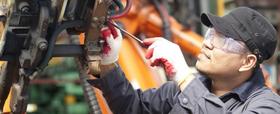Has the US Automotive Sector Shifted Safely Into Top Gear?

The bail-out for the US automotive industry, at a cost of $80 billion and large-scale layoffs, traumatized the United States. Automobile manufacturers have regained their competitiveness and are benefiting from the upturn in US economic growth, which is forecast at 2.9% in 2015. The industry has recovered and demand is being driven partly by easier access to credit, but at what price? In a Panorama report focused on the sector. Coface predicts a 3.8% increase in auto sales in 2015 compared to last year, a sustained level of growth but well below the level recorded in recent years.
The sector needs to continue to look towards the future and to make the changes necessary to meet new challenges ahead.
A recovery sustained by domestic consumption, and recently, increased investment
After a 35% collapse when the crisis hit, car sales in the United States in 2014 were back at 2007 levels. The recent fall in oil prices (-48% in 2014) is undoubtedly a contributing factor. But the recovery is also being driven by two additional trends.
The first is that the US economic recovery has meant households have benefitted from very low interest rates. Easier access to credit has bolstered purchasing power and enabled vehicle replacement. This improvement in living standards is also being driven by wages rising faster than prices. With the fall in unemployment levels, companies are increasing the pay of skilled workers. All of this is helping to boost the economic confidence of American households.
The second factor is the positive economic environment that is encouraging auto companies to relocate production in the country. Investments in increasing automation in the production process reduce the correlation between labor costs and location. As a result, with a few exceptions, all the world’s leading automobile and automobile equipment manufacturers are now located in the United States. National and state authorities have provided strong support for the sector, by holding down interest rates and implementing supporting policies such as “scrappage programs” and the injection of almost 80 billion dollars into GM and Chrysler.
Disenchantment with the car?
The fall in unemployment, however, has tended to bypass the younger generation. “Millennials” are not fully integrated into this virtuous cycle and are prolonging their years in education in an attempt to maximize their chances of gaining employment. Their high levels of student loan debt are causing Millenials to either delay vehicle purchases or become high-risk borrowers. In addition, they seem to attach less importance to vehicle ownership, making increased use of alternative forms of transport. The number of 20-29 year olds with drivers licenses fell by 9% between 1995 and 2010, an indication of disenchantment with the car.
There is also a downside to easy access to low interest rate credit. Banks are granting more credit to those in the “subprime” categories with the aim of increasing the profitability of their outstanding loans. These include so-called “high risk” households, and the numbers of payment defaults have increased significantly and will continue to rise in 2015.
Another possible source of tension is that the Federal Reserve could very well raise interest rates this year. This would add to the pressures on households with high debt and variable rate loans, and possibly force them to dispose rapidly of their vehicles.
An industry focused on change
Manufacturers need to adapt their supplies and define a model for this changing demand. The strength of R&D investment will be critical in a supply-led sector, such as automotive, where new models play a direct role in driving sales, by stimulating consumer aspirations.
Contact
Annie Lorenzana
COMMUNICATIONS MANAGER
North America
MOB: +1 (407) 221-3496
Annie.Lorenzana@coface.com








